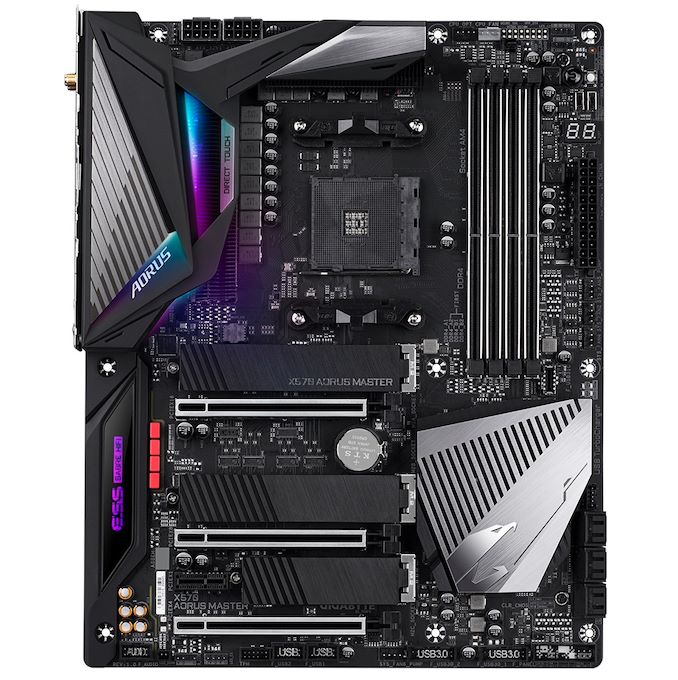The AMD X570 Motherboard Overview: Over 35+ Motherboards Analyzed
by Gavin Bonshor on July 9, 2019 8:00 AM ESTGIGABYTE X570 Aorus Master
Moving down the product stack from GIGABYTE's X570 SKU list is the GIGABYTE X570 Aorus Master which has a range of high-end features such as 2.5 Gigabit LAN, three PCIe 4.0 M.2 slots, and Intel's Wi-Fi 6 802.11ax wireless interface. The GIGABYTE X570 Aorus Master could be considered its flagship for general consumers without the hefty price tag attached to the higher grade X570 Aorus Extreme ($699).
Included is support for up to 128 GB of DDR4 memory across its four slots, with support for DDR4-4400 with three PCIe 4.0 x4 M.2 slots each with its own individual M.2 heatsink, and six SATA ports. There are three full-length PCIe 4.0 slots which operate at x16, x8/x8, and x8/x8/x4, with a single PCIe 4.0 x1 slot. On the power delivery front, GIGABYTE is using a formidable setup with a 12+2 design with power stages rated for 50 A, and with two 8-pin 12 V ATX CPU power inputs. The boards aesthetic is focused on the outer edges with a rear panel cover with RGB LEDs which stretches down to the audio PCB. For the X570 chipset, there's an actively cooled chipset heatsink which encompasses the Aorus Falcon into the design.
The onboard audio is handled by a Realtek ALC1220-VB HD audio codec and is complemented by an ESS Sabre 9118 DAC chip to enhance the auditory quality. This equates to five 3.5 mm audio jacks with a single S/PDIF optical output. Also on the rear panel is a Q-Flash Plus button for updating the firmware, a clear CMOS button, three USB 3.1 G2 Type-A, one USB 3.1 G2 Type-C, two USB 3.1 G1 Type-A and four USB 2.0 ports. The board's rear panel networking capabilities consist a Realtek RTL8125AG 2.5 G port with an assisting Intel Gigabit port for dual networking, as well as an Intel AX200 802.11ax Wi-Fi 6 wireless interface which also includes support for BT 5 devices.
GIGABYTE's X570 Aorus Master targets gamers and enthusiasts looking to push their processors further than the rated specifications, as well as offering 2.5 G and Wi-Fi 6 capable networking. The pricing reflects this with a price tag of $359 which puts it in the upper echelon of models, but the price seems fair all things considered.












225 Comments
View All Comments
DigitalFreak - Tuesday, July 9, 2019 - link
I think the only advantage of using a 2000 series CPU with an X570 board will be PCIe 3.0/4.0 support. The X370/X470 only supported PCIe 2.0. In theory, the connection from the 2000 processor to the X570 chipset should run at PCIe 3.0 speeds.FreckledTrout - Tuesday, July 9, 2019 - link
The x370 chipset and x470 both supported PCIe 3.0 with either a 1xxx or 2xxx Ryzen CPU. If you are not running a 3xxx CPU in the x570 board there isn't any major feature that should cause one to want to upgrade.DigitalFreak - Tuesday, July 9, 2019 - link
@FreckledTrout - Yes and no. The interconnect between the CPU and the chipset is PCIe 3.0 on X370 / X470, but all the PCIe lanes that come off the chipset are 2.0. Running a 2000 series CPU in an X570 board would give you a PCIe 3.0 link between the CPU and the chipset, with either PCIe 3.0 or 4.0 lanes coming off the chipset (depends on if AMD drops everything to PCIe 3.0 with a 2000 series processor).extide - Tuesday, July 9, 2019 - link
It looks like they still allow the chipset lanes to be 4.0. So you'd have 3.0 link to cpu, but 4.0 from chipset to devices.Targon - Thursday, July 11, 2019 - link
Since you have at least one or two PCI Express slots that are connected to the CPU, not chipset, that almost becomes a non-issue. On my Asus ROG Crosshair VI Hero(X370), you have PCI Express 3.0 x16 for the first slot, or x8/x8. The third PCI Express x16 slot is a 2.0 I believe, which is still enough to get the job done for many devices. Even with the X570 board with a first or second generation Ryzen processor, the most you end up with is an extra 3.0 supporting slot. Note that many boards may have x16 slots, but they are x8 electrically, so you won't see the full bandwidth anyway in those slots.sorten - Tuesday, July 9, 2019 - link
Thanks Gavin! This is a great resource and is exactly what I needed to help build my new system.willis936 - Tuesday, July 9, 2019 - link
The return of the 40mm fan! Those are the most obnoxious components ever. No one has missed them in the past ten years.Kastriot - Tuesday, July 9, 2019 - link
Buy Asrock aqua and problem solved.FreckledTrout - Tuesday, July 9, 2019 - link
I'm waiting for the next iteration of board for this reason. I'm speculating the next round the chipset will be on 7nm.abufrejoval - Tuesday, July 9, 2019 - link
The genious about that chiplet design is that the chipset doesn't actually benefit nearly as much from the shrink, as pure logic or SLC caches: The monolithic guys pay the 7nm overhead (e.g. EUV) for I/O while the geometry of the transistors in the I/O area is mostly determined by the need to power long motherbord or even slot traces.So while waiting is never a bad idea when your need clearly isn't overwhelming you, waiting for that shrink could turn out rather long. These days I/O heave chips might never be done in smaller geometries, because of that and because packaging has matured.